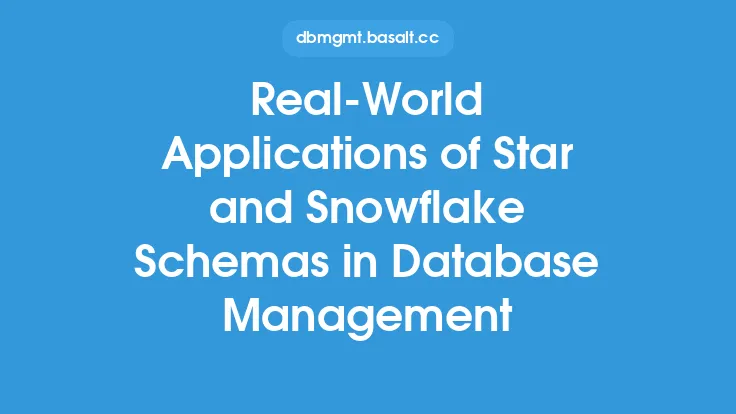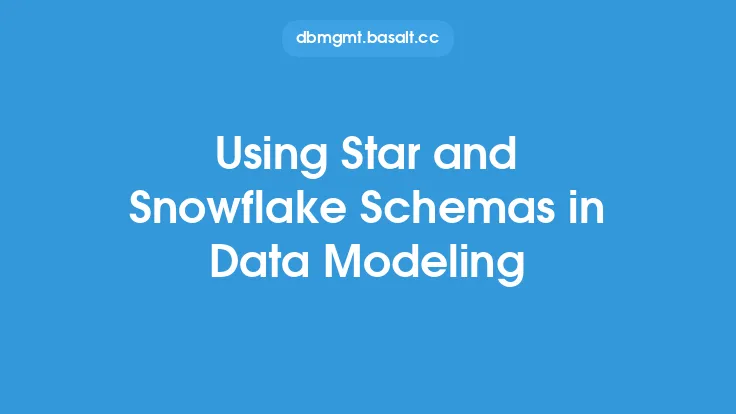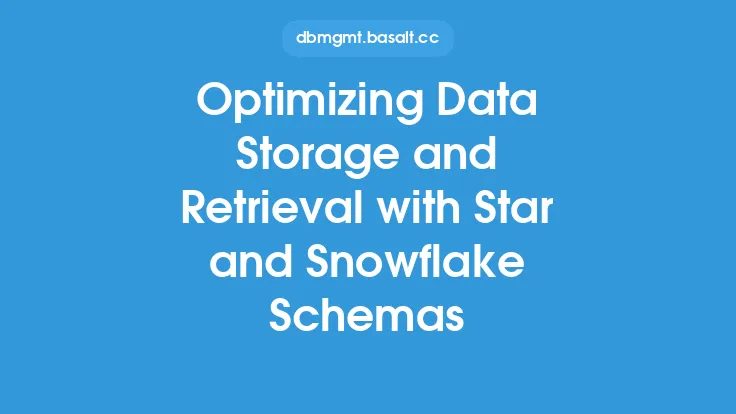Data denormalization is a crucial aspect of database design, particularly in data warehousing and business intelligence applications. It involves organizing data in a way that improves query performance, reduces complexity, and enhances data retrieval. Two popular schema designs used in data denormalization are star and snowflake schemas. These schemas have been widely adopted in various industries due to their ability to optimize data storage and retrieval. In this article, we will delve into the benefits of using star and snowflake schemas in data denormalization, exploring their advantages, and how they can be leveraged to improve data management.
Introduction to Star Schemas
Star schemas are a type of denormalized database design that consists of a central fact table surrounded by dimension tables. The fact table contains measurable data, such as sales or website traffic, while the dimension tables provide context to the data, including time, location, and product information. Star schemas are ideal for data warehousing and business intelligence applications, as they enable fast query performance and simplify complex data relationships. The benefits of star schemas include improved query performance, reduced data redundancy, and enhanced data retrieval.
Introduction to Snowflake Schemas
Snowflake schemas are an extension of star schemas, where each dimension table is further normalized into multiple related tables. This design is useful when there are multiple levels of granularity in the data, such as a product hierarchy with categories, subcategories, and individual products. Snowflake schemas provide a more detailed and nuanced view of the data, enabling more precise querying and analysis. The benefits of snowflake schemas include improved data flexibility, enhanced data granularity, and reduced data redundancy.
Benefits of Star and Snowflake Schemas
Both star and snowflake schemas offer several benefits in data denormalization, including:
- Improved query performance: By denormalizing data and reducing joins, star and snowflake schemas enable faster query execution and improved system responsiveness.
- Simplified data relationships: Star and snowflake schemas simplify complex data relationships, making it easier to understand and analyze data.
- Enhanced data retrieval: These schemas provide a more intuitive and user-friendly way of retrieving data, enabling business users to easily access and analyze data.
- Reduced data redundancy: By eliminating redundant data, star and snowflake schemas reduce data storage requirements and improve data consistency.
- Improved data flexibility: Snowflake schemas, in particular, provide a more flexible data structure, enabling easier adaptation to changing business requirements.
Advantages of Star Schemas
Star schemas have several advantages, including:
- Fast query performance: Star schemas are optimized for query performance, making them ideal for data warehousing and business intelligence applications.
- Simple data structure: Star schemas have a simple and intuitive data structure, making it easy to understand and maintain.
- Easy data retrieval: Star schemas provide a straightforward way of retrieving data, enabling business users to easily access and analyze data.
Advantages of Snowflake Schemas
Snowflake schemas have several advantages, including:
- Improved data granularity: Snowflake schemas provide a more detailed and nuanced view of the data, enabling more precise querying and analysis.
- Enhanced data flexibility: Snowflake schemas offer a more flexible data structure, enabling easier adaptation to changing business requirements.
- Reduced data redundancy: Snowflake schemas reduce data redundancy by normalizing dimension tables, improving data consistency and reducing storage requirements.
Best Practices for Implementing Star and Snowflake Schemas
To get the most out of star and snowflake schemas, it's essential to follow best practices, including:
- Carefully designing the schema: The schema design should be carefully planned and executed to ensure optimal performance and data retrieval.
- Using data warehousing tools: Data warehousing tools, such as ETL software, can help simplify the process of designing and implementing star and snowflake schemas.
- Monitoring and maintaining the schema: The schema should be regularly monitored and maintained to ensure optimal performance and data consistency.
Conclusion
Star and snowflake schemas are powerful tools in data denormalization, offering several benefits, including improved query performance, simplified data relationships, and enhanced data retrieval. By understanding the advantages and disadvantages of each schema, organizations can make informed decisions about which schema to use and how to implement it. By following best practices and carefully designing and maintaining the schema, organizations can unlock the full potential of star and snowflake schemas and improve their data management capabilities. Whether you're designing a data warehouse or optimizing an existing database, star and snowflake schemas are essential components of a well-designed data management system.





